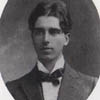Your shopping cart is empty!
Select currency
MENU

In the autobiographical Outline, Paul Nash, a friend and contemporary at The Slade, writes of Claughton Pellew’s ‘devotional approach’ to the natural world. Nash also acknowledges Claughton Pellew’s influence in teaching him to look – to attend properly to that which surrounded him. This looking and attending, minutely and yet not with accuracy only but with the kind of passionate intensity which accompanies a deep feeling for, even love of, the natural world, is clearly apparent in Claughton Pellew’s work.
Born in Redruth, Cornwall, on April 11th 1890, Claughton Pellew’s father, William Pellew-Harvey, was a mining engineer and his mother, Elizabeth (née Hitchins) was an artist. Soon after his birth the family moved to Canada. There they travelled on the Canadian Pacific Railway - on journeys, Claughton Pellew would recall, through landscapes of mountains, lakes and huge forests, before they returned to London where William Pellew-Harvey would set up a mining consultancy.
After attending Merchant Taylor’s School (1902-1906) Claughton Pellew started at the Slade (1907-1911) where his tutors were Henry Tonks and Wilson Steer, and his contemporaries included Ben Nicholson, Paul Nash and Stanley Spencer. Just after his training Claughton Pellew visited Italy. Here the art of the Florentine Quattrocento would impress him deeply – not only as art, but for its religious symbolism too. Prior to the journey to Italy he had felt himself drawn to Roman Catholicism, but his visit there, particularly the time he spent in Assisi (1913), undoubtedly influenced his decision to convert to Roman Catholicism.
His Catholicism, would, in turn, influence his position on the 1914-18 war. Claughton Pellew was received into the church in early 1914, just before the outbreak of the War, and during the latter part of the war (conscription was introduced only in 1916) he was confined as a conscientious objector in Home Office Works Centres at Dyce near Aberdeen, then at the Wakefield Centre and finally at Dartmoor.
Objectors to the war were handled with more or less severity – some were permitted full exemption from service in any form, most were expected to serve non-directly, and others were incarcerated for the full duration. Claughton Pellew suffered inordinately from his confinement. And the sense of ostracism and sheer physical hardship was made all the more difficult to bear when upon his release he found that other artists – the better-connected Bloomsbury artists Duncan Grant and Mark Gertler, for instance – had avoided imprisonment. John Nash, who by this time had got to know Claughton Pellew through his brother Paul, suggested that these war experiences had left his friend with a ‘sense of permanent isolation from which [he] never recovered’.
Claughton Pellew married Emma Marie (‘Ketchie’) Tennent (1919) who had also studied at the Slade and who, during the War, had likewise become a Roman Catholic. Together they moved to a remote village in rural north Norfolk where after several years, with the help of a local builder, they designed and built their own house, The Pightle. Here they lived a simple life: they used paraffin lamps; they rode bicycles instead of driving a car, and they gardened. They rarely left Norfolk, but on several occasions (1923/1929-3) they travelled to Bavaria, staying at Tutzing on the Starnbergerzee where the lakes and trees must have reminded Claughton Pellew of his early years in Canada, and the landscapes were spur to the creation of drawings and watercolours by both.
Claughton Pellew continued to paint, and towards the end of the decade he also experimented with etching; but it is perhaps as a wood engraver that he is primarily known. He began wood engraving in 1923 and in that year exhibited three engravings at the annual Society of Wood Engravers’ exhibition. By the middle of the decade Claughton Pellew was working on larger scale engravings – From My Window (1925) for instance – which have a surety of line, and wherein he also achieves a rich variation of textures.
Claughton Pellew did not exhibit very much – only a handful of exhibitions in his life-time can be counted: at the New English Art Club (1925), and with the Society of Wood Engravers (1923; 1930; ’32). He was too retiring on the whole, and self-effacing, and moreover he lived in such a remote area that mixing with his contemporaries, and thereby finding a recognizable place amongst them, was never achieved in his life-time. In content, however, there are similarities to the kind of themes of rural peace and harmony, and in antithesis, of a dislike of the modern, which were explored by the inter-war neo-romantics - by Eric Ravilious, John Piper, Graham Sutherland and Robin Tanner. Claughton Pellew wanted – and in many senses found in the ways in which he lived - a return to the clearer certainties of pre-war Britain, a world before the machine had become omnipresent and the city’s invasive sprawl had covered so much of the countryside. The recurring images in his work are of rural scenes – of hayricks, trees, animals and the elements.
Claughton Pellew died in 1966, a relatively unknown artist. After his death, and more latterly, there has been far more interest in the work of this shy yet intense watercolourist and wood engraver. Exhibitions of his work were held at Norwich in 1967, at the Ashmolean in Oxford in 1987 (primarily wood-engravings), and a series of exhibitions were held at Hove, London, King’s Lynn and Exeter during 1990, and then at King’s Lynn in 2001.
Ashmolean Museum, Oxford; British Museum, London; Victoria & Albert Museum, London; Fitzwilliam Museum, Cambridge; City Art Gallery, Manchester; Castle Museum & Art Gallery, Norwich, and Hove Museum & Art Gallery, Brighton.
This is a Limited Edition Giclee Print by the artist Claughton Pellew 450mm x 600mm ..
£225.00 Ex Tax: £187.50